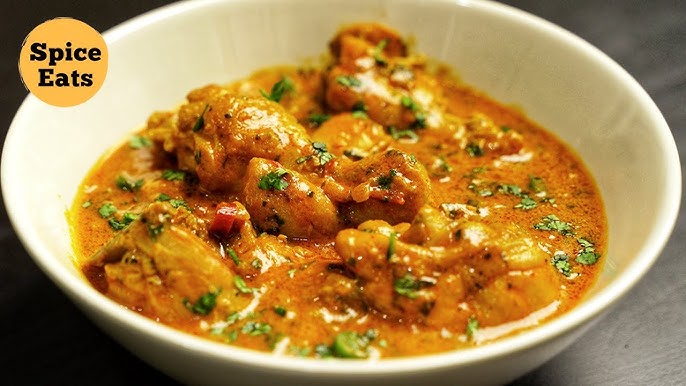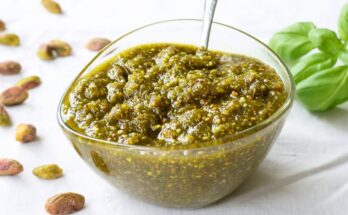Curry Recipe: Curry is a culinary masterpiece, beloved for its rich, aromatic flavors and endless customization options. Whether you’re cooking a spicy Indian masala, a creamy Thai curry, or a hearty stew-like Japanese curry, this dish is your gateway to bold and comforting meals.
In this guide, we’ll walk you through a detailed, easy-to-follow process to create your perfect curry. So, roll up your sleeves and get ready to bring a flavorful burst of warmth to your table!
What is Curry?
Curry is a broad term that refers to a spiced dish, often featuring a sauce or gravy, originating from South and Southeast Asia. However, curry has transcended borders, becoming a global favorite with countless regional variations.
Origins and Cultural Significance: The word “curry” is thought to come from the Tamil word “kari,” meaning sauce. Over time, it evolved, influenced by local ingredients and cooking styles. From India to Thailand and beyond, curry is a cultural icon, representing hospitality and celebration.
Types of Curries:
- Indian Curries: Often feature a blend of spices like turmeric, cumin, and coriander.
- Thai Curries: Use aromatic pastes made with chilies, lemongrass, and coconut milk.
- Japanese Curries: Milder, sweeter, and thicker, served over rice.
Ingredients You’ll Need
A great curry starts with the right ingredients. Here’s a breakdown:
Base Ingredients:
- Onions, garlic, and ginger: Essential for flavor.
- Tomatoes or tomato paste: Adds depth and tanginess.
- Cooking oil or ghee: Helps sauté the aromatics.
Spices:
- Ground spices: Turmeric, cumin, coriander, and garam masala.
- Whole spices: Cardamom pods, cinnamon sticks, and bay leaves.
- Fresh herbs: Cilantro and curry leaves.
Optional Add-Ins:
- Coconut milk or cream for richness.
- Yogurt for a tangy twist.
- Chilies for heat.
Essential Kitchen Tools
Before you dive in, gather these tools for an efficient cooking process:
- A heavy-bottomed pot or skillet to prevent sticking.
- Sharp knives for chopping vegetables and proteins.
- A spice grinder or mortar and pestle to make fresh spice blends.
- A blender or food processor for smooth curry bases.
Pro Tip: If you don’t have a mortar and pestle, use the back of a spoon to crush whole spices.
Preparing for Your Curry Adventure
Preparation is key to a stress-free cooking experience. Here’s how to get started:
Mise en Place (Everything in Its Place): Chop your onions, garlic, and ginger. Measure out spices and keep them handy. Dice vegetables and cut proteins into bite-sized pieces.
Chopping Tips:
- Onions: Dice finely for a smoother curry or leave larger chunks for texture.
- Ginger and Garlic: Grate or mince for better integration into the sauce.
Spice Blending:
Mix ground spices in a bowl to save time during cooking. Toast whole spices in a dry pan for enhanced aroma.
Creating the Curry Base
The base is the heart of any curry, providing depth and flavor. Follow these steps:
- Sauté Aromatics: Heat oil in your pot. Add onions and cook until golden brown. Follow with garlic and ginger for a minute until fragrant.
- Add Tomatoes: Stir in chopped tomatoes or tomato paste. Cook until they break down into a thick, jam-like consistency.
- Incorporate Spices: Sprinkle your pre-measured spice mix into the base. Cook for 1-2 minutes to release their full flavor.
- Deglaze the Pot: Add a splash of water or stock to scrape up any browned bits stuck to the bottom.
Adding Proteins and Vegetables
Now that your curry base is flavorful and aromatic, it’s time to add the main ingredients that make your dish hearty and satisfying.
Proteins: Depending on your preference, you can add:
- Chicken: Add bone-in pieces for extra flavor or boneless chunks for quicker cooking. Brown the chicken in the base for a few minutes to seal in the juices.
- Beef or Lamb: These take longer to cook, so simmer gently for tender results.
- Vegetarian Proteins: Paneer, tofu, or lentils are excellent options for a plant-based curry.
Vegetables:
Vegetables like potatoes, carrots, bell peppers, or green beans work well in curry. Harder vegetables should be added earlier, while softer ones like zucchini or spinach can go in during the last few minutes.
Pro Tip: For evenly cooked proteins and veggies, cut them into similar-sized pieces.
Balancing Flavors in Curry
The secret to a great curry lies in balancing its bold flavors. Here’s how to fine-tune your dish:
- Adjust Sweetness: If your curry tastes too spicy or tangy, add a pinch of sugar, honey, or a splash of coconut milk to mellow the flavors.
- Enhance Acidity: To brighten the dish, squeeze in some fresh lime juice or add a splash of vinegar toward the end of cooking.
- Control Heat: If the curry is too spicy, add more cream, yogurt, or coconut milk. Conversely, if it lacks heat, toss in some chopped chilies or chili powder.
- Salt: Salt is essential for flavor, so taste as you go and adjust gradually.
Troubleshooting Tip: If your curry is overly salty, add a peeled potato while simmering—it will absorb some of the excess salt.
Simmering and Perfecting Your Curry
Simmering allows all the flavors to meld beautifully, creating a cohesive and delicious dish.
- Low and Slow: Keep the heat low and let the curry simmer gently. Stir occasionally to prevent sticking.
- Monitor Consistency: If the curry looks too thick, add a splash of water or stock. If it’s too thin, let it simmer uncovered to reduce.
- Tasting: Periodically taste your curry to ensure it’s developing the right balance of flavors. Adjust spices, salt, and other elements as needed.
Pro Tip: Add a dollop of butter or ghee before serving for a luxurious finish.
Serving the Curry
Curry pairs beautifully with various side dishes, enhancing its flavors and making it a complete meal.
- Rice: Steamed basmati rice is a classic choice, but jasmine rice or brown rice also works well.
- Bread: Serve with warm naan, parathas, or roti to scoop up the flavorful sauce.
- Condiments: Accompany your curry with chutneys, pickles, or yogurt-based raita to add contrasting textures and flavors.
- Garnishing: Sprinkle fresh cilantro, a squeeze of lime, or a dash of cream on top for a polished presentation.
Popular Curry Variations
Let’s explore some of the most popular curry recipes you can try at home:
- Classic Chicken Curry: A robust and hearty dish made with tender chicken, a tomato-based sauce, and traditional Indian spices.
- Vegetarian Curry: Packed with vegetables and legumes like chickpeas or lentils, this curry is a nutritious and flavorful choice.
- Coconut-Based Curry: Often found in Thai cuisine, this curry features coconut milk, lemongrass, and fresh chilies for a creamy and fragrant dish.
Common Mistakes to Avoid
Even seasoned cooks can make errors when preparing curry. Here’s how to avoid them:
- Skipping the Spice Toasting: Toasting spices enhances their flavors, so don’t rush through this step.
- Adding Dairy Too Soon: Yogurt or cream should be added at the end to prevent curdling.
- Overcooking Vegetables: Add softer vegetables last to retain their texture and color.
- Ignoring Consistency: Curries should have a luscious, sauce-like consistency. Avoid making them too watery or overly thick.
Storage and Reheating Tips
Homemade curry often tastes even better the next day as the flavors deepen. Here’s how to store and reheat it properly:
Storage:
- Allow the curry to cool completely before transferring it to an airtight container.
- Store in the refrigerator for up to 3-4 days.
Reheating:
- Use a microwave or stovetop to gently reheat the curry. Add a splash of water if it has thickened.
- Stir occasionally to ensure even heating.
Freezing Tip: Curries with coconut milk may separate when frozen, so freeze without the coconut milk and add it fresh when reheating.
Health Benefits of Eating Curry
Did you know curry is more than just a comfort food? It’s also packed with health benefits!
- Spices: Turmeric is anti-inflammatory, cumin aids digestion, and garlic boosts immunity.
- Nutritional Value: Adding vegetables, proteins, and legumes makes curry a balanced meal.
- Homemade Advantage: Cooking curry at home lets you control the ingredients and reduce unhealthy fats or sodium.
FAQs about Curry Recipe
1. What basic ingredients do I need for a curry recipe?
To make a basic curry, you’ll need oil, onions, garlic, ginger, tomatoes (fresh or canned), curry powder or paste, and a main ingredient like chicken, beef, seafood, or vegetables. Adjust spices like turmeric, cumin, and coriander to taste.
2. Can I make a vegetarian or vegan curry?
Absolutely! For a vegetarian curry, you can use a variety of vegetables such as cauliflower, potatoes, carrots, and peas. Chickpeas, lentils, and tofu make excellent protein-rich additions for a vegan curry.
3. How can I make my curry more flavorful?
Enhance your curry by sautéing onions and garlic until golden before adding spices. This base, known as a masala, provides a depth of flavor. Also, consider toasting whole spices before grinding them, and use fresh herbs like cilantro for garnish.
4. Is it necessary to use coconut milk in a curry?
No, it’s not necessary, but coconut milk adds richness and a creamy texture to curries, particularly in Thai and South Indian styles. If you prefer, you can use yogurt, cream, or a non-dairy alternative like almond milk.
5. What’s the best way to serve curry?
Curry pairs wonderfully with steamed rice or flatbreads like naan or roti. You can also serve it with side dishes such as lentil dal or a fresh salad to balance the hearty flavors.
6. How can I adjust the spiciness of my curry?
Control the heat by varying the amount of chili peppers, cayenne pepper, or hot curry powder. Starting with less and adding as you taste allows you to customize the spiciness to your preference.
7. Can I make curry in advance?
Yes, curry often tastes better the next day as the flavors have more time to meld. Just store it in an airtight container in the refrigerator and gently reheat it before serving.
Conclusion
Making curry at home is a rewarding experience that fills your kitchen with tantalizing aromas and delivers bold, comforting flavors to your table. Whether you’re a beginner or an experienced cook, this step-by-step guide ensures success every time.
Don’t be afraid to experiment—customize your curry with your favorite ingredients and flavors. Once you master the basics, the possibilities are endless!



